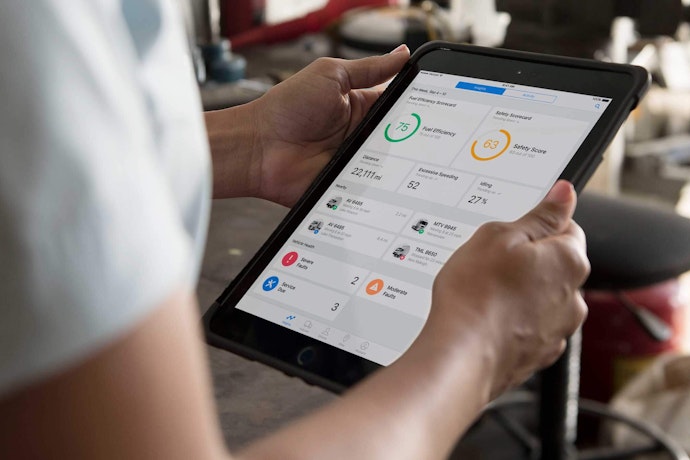How Smart Video Fuels Smart Business
Learn how video solutions with intelligent analysis capabilities can help benefit your drivers and enhance safety programs.
Read more
Guest post by Jeff Langley, Fleet Account Executive, Adrian Steel Company
Fleet maintenance is the process of maintaining your fleet vehicles and keeping on top of routine maintenance schedules. This helps keep both your fleet vehicles and drivers safe and your vehicles on the road longer, which in turn enables your business to stay profitable—all helping your bottom line.
And as a fleet manager, your needs may be growing—as technology becomes more sophisticated across vehicle class segments, the skills and parts to maintain them are incrementally more complicated and expensive. In some cases, parts take longer to service or require the need for electronic diagnostics. Combined with skilled technician shortages, all of this means that maintenance can be difficult to manage in the modern age.
However, even though it is such a critical part of your business, there is no reason to let maintenance consume your fleet management duties and responsibilities, from cost containment and staying within budget or in considering vehicle uptime and productivity. Just as vehicle technology becomes more sophisticated, so too does the fleet tracking software that helps managers stay on top of it. A more sophisticated fleet management system means the ability to provide solutions that allow organizations to focus on the job at hand—and not on oil changes and tire pressure.
Most fleet managers know that vehicle maintenance takes two forms: scheduled and unscheduled:
Developing and implementing an effective fleet maintenance program can be easy, and the results rewarding. There are tools and technologies available that can make it easier than ever before to save company time, frustration and money when it comes to staying on track when it comes to vehicle maintenance.
When developing your fleet’s maintenance plan, ask yourself these five questions:
Once you have the answers to those questions, tap into these five maintenance planning tips to help keep your fleet running smoothly.
What should be included in routine preventative fleet maintenance service? You will want to create yours based on your fleet’s needs and unique makeup, but many checklists include these items:
Who will be responsible for preventive fleet maintenance? Your drivers are the first line of defense against unexpected breakdowns and repairs. By having drivers complete daily vehicle inspections and DVIR reports mandated by the DOT, they allow you to address issues while they’re still minor and help prevent costly unscheduled fixes down the line.
It’s critical that they immediately report any vehicle problems to help keep your vehicles on the road. Drivers can and should be trained to monitor basic vehicle safety items (tires, brakes, steering, etc.); vehicle performance issues (including misfires and rough idling); and miscellaneous items (such as the heater or radio).
Your repair technicians—whether in-house or outsourced—can perform more detailed inspections on each vehicle’s components and systems. If you outsource repairs, be sure to supply the vendor with your own preventive maintenance checklist. Shops may focus on breakdown maintenance, not preventive maintenance.
Develop a preventative maintenance schedule that works for your fleet. Miles traveled, engine hours, fuel usage, and calendar time are the typical guides used to create a schedule. By also tracking the number of breakdowns, jumpstarts, tows, and emergency repairs, you might see patterns that require adjustments to your schedule.
To find more information about fleet maintenance schedules, here are a few informative sites to get you started:
Fleet managers should take advantage of technology. If you’re still entering and tracking data manually, seriously consider upgrading to a digital system. Manual systems can be tedious and time-consuming, no matter the fleet size. Computerized systems are a more efficient method for compiling maintenance reports, allowing you to make faster, better decisions that will impact your business both in the short and long term.
Telematics also allows you to examine your drivers’ performance, so you can offer important feedback and make recommendations. It’s difficult to know exactly how your drivers behave behind the wheel when you’re not there, which is why you need a way to make sure that harsh driving events are not negatively affecting your fleet and driver safety.
The technology you need is out there, and it can be surprisingly affordable; a little research and legwork from you can make your job much easier. You probably already know that it’s a valuable way to keep tabs on driver safety and behavior from afar, but it’s not just tracking them. It can also flag any untoward events like speeding over a certain threshold, braking harshly and excessive idling – which lets you stop these fuel-wasting, vehicle-damaging occurrences as they happen.
The time you spend now to develop your fleet’s preventive maintenance plan could save your company a considerable amount of lost time in the future. In addition, the money you spend on implementing a preventive maintenance plan will be small in comparison to maintenance costs associated with unscheduled, preventable repairs. In this case, a dime of prevention is definitely worth a dollar of cure.
Learn how world-class fleet management software from Verizon Connect can help you get the most from your fleet maintenance program by scheduling a demo today.
Tags: Cost control, Dispatching & Scheduling, Field management, Inspections, Productivity & Efficiency, Revenue & ROI, Safety, Vehicle Maintenance, Fleet utilization




Find out how our platform gives you the visibility you need to get more done.
Learn how video solutions with intelligent analysis capabilities can help benefit your drivers and enhance safety programs.
Read moreAre you ready for vehicle tracking? Go through our checklist to learn the signs you’re ready to add fleet tracking to...
Read moreTechnology adoption helps fleets navigate operational obstacles. Learn what fleet management industry technology trends...
Read moreLearn how telematics can lead to operational improvements.
Read more
Get your free 2024 Fleet Technology Trends Report and see how organizations are: